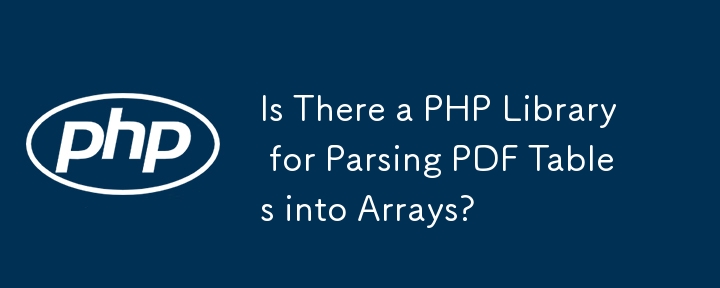Found a total of 10000 related content

Solutions that PHP generates Excel file not open in Microsoft Excel
Article Introduction:This article provides a detailed solution to the problem that it cannot be opened in Microsoft Excel when generating Excel files in PHP, but can be opened in Chrome plug-in. Ensure that the generated Excel file can be opened and used normally in Microsoft Excel by modifying Content-Type to the correct TSV type, or using the PhpSpreadsheet library to generate a real XLS file.
2025-08-16
comment 0
493

Solution to Generate Excel Files Not Opened in PHP with Microsoft Excel
Article Introduction:This article aims to resolve the issue where Excel files generated using PHP cannot be opened in Microsoft Excel, but can be opened with Chrome extensions. By analyzing common reasons and providing two solutions for modifying Content-Type and using PhpSpreadsheet library, we help developers correctly generate and export Excel files that can be opened normally in Microsoft Excel.
2025-08-15
comment 0
688

Simplifying Excel Table Parsing in Node.js with @libs-jd/xlsx-parse-table
Article Introduction:Find the library on GitHub or npm
Working with Excel files in Node.js applications can be challenging, especially when dealing with complex table structures. Today, I’m excited to introduce you to a powerful new library that simplifies this process
2024-11-11
comment 0
571
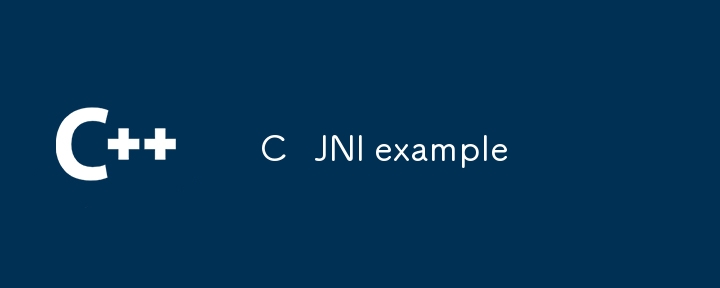
C JNI example
Article Introduction:First, write a Java class that declares native methods, 2. Compile Java and generate JNI header files, 3. Use C to implement functions in the header files, 4. Compile C code as a dynamic library (Linux/macOS is .so, Windows is .dll), 5. Run Java programs and load the library to call native methods, and finally output "HellofromC viaJNI!", and the entire process fully realizes the function of Java calling C code through JNI.
2025-08-06
comment 0
719
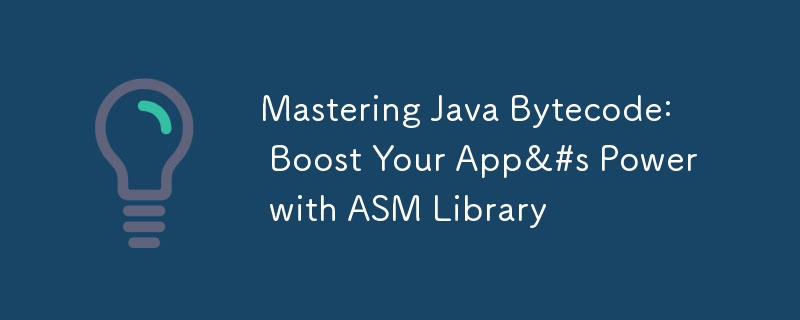
Mastering Java Bytecode: Boost Your App&#s Power with ASM Library
Article Introduction:Java bytecode manipulation is a powerful technique that allows us to modify Java classes at runtime. With the ASM library, we can read, analyze, and transform class files without needing the original source code. This opens up a world of possibilitie
2024-11-24
comment 0
523

What is the autoload section in composer.json?
Article Introduction:Composer.json's autoload configuration is used to automatically load PHP classes, avoiding manual inclusion of files. Use the PSR-4 standard to map the namespace to a directory, such as "App\":"src/" means that the class under the App namespace is located in the src/ directory; classmap is used to scan specific directories to generate class maps, suitable for legacy code without namespace; files are used to load a specified file each time, suitable for function or constant definition files; after modifying the configuration, you need to run composerdump-autoload to generate an automatic loader, which can be used in the production environment --optimize or --classmap-
2025-06-12
comment 0
637

PHP Online Reading Excel File Tutorial: No Downloads required
Article Introduction:This article details how to use PHP to read Excel files online without downloading them locally. By leveraging the cURL library, we can directly obtain Excel files from the URL and parse and process them using libraries such as PhpSpreadsheet. This article provides a validated cURL sample code and explains key header settings to help developers avoid common download problems, enabling efficient online Excel data reading.
2025-08-23
comment 0
330

Challenges and solutions for handling CNAB files: Application of jrodella/cnab-layouts-parser library
Article Introduction:I encountered a tricky problem when dealing with bank reconciliation files: I needed to parse and generate files in CNAB format that contained details of bank transactions. Initially, I tried to write parsing and generating code manually, but found the process was very complicated and error-prone. Fortunately, I found the jrodella/cnab-layouts-parser library, which greatly simplifies this task. Composer can be learned through the following address: Learning address
2025-04-18
comment 0
1190

Including Files in PHP
Article Introduction:The difference between include and require in PHP is in error handling: when include error occurs, it will issue a warning and continue execution, suitable for non-core files; when require error occurs, it will trigger a fatal error and stop the script, suitable for core files. 1. include_once and require_once can avoid duplicate inclusion and are suitable for function libraries, configuration files, etc. 2. It is recommended to use __DIR__ to build a stable path to prevent path errors. 3. Sensitive files should be prohibited from external access to prevent information leakage. 4. It is recommended to use require_once for the core class library to ensure that it is loaded without duplication. 5. In terms of performance include/require is slightly faster, but the differences can be made in actual development.
2025-07-18
comment 0
759

PHP Master | Adding Text Watermarks with Imagick
Article Introduction:Imagick PHP extension library details: Add text watermark to images
This article will explain how to use PHP's Imagick extension library to add text watermarks to images. We will explore a variety of methods, including simple text overlay, creating transparent text watermarks using font masks, and more advanced text tiling techniques.
Key points:
Imagick is a powerful PHP extension library that can be used to process images, including adding text watermarks.
Text watermarking can be achieved by creating an Imagick class instance, reading an image, setting the font properties using the ImagickDraw instance, and then adding text to the image using the annotateImage() method.
There are many ways to add text
2025-02-25
comment 0
365

How to use Livewire for building dynamic interfaces in Laravel?
Article Introduction:Livewire is a powerful Laravel library that allows developers to build dynamic, responsive interfaces using only PHP without writing JavaScript. 1. First install Livewire through Composer and add @livewireStyles and @livewireScripts in the main layout to complete the basic setup. 2. Use the Artisan command phpartisanmake:livewire to create components, generate corresponding PHP classes and Blade view files, such as implementing a to-do list, and manage state and interaction through public properties and methods. 3. Use key features such as wire:model to achieve bidirectional
2025-08-01
comment 0
749

PHP file dual purpose: best practices for front-end API and back-end library
Article Introduction:This article will explore in-depth how to optimize PHP files so that they can serve as both an API interface for front-end AJAX requests and a function library that can be safely referenced by back-end PHP scripts. We will analyze common problems, such as accidental execution of complete logic when a file is included, and provide various strategies such as conditional judgment, modular design, and consistent parameter management to ensure the clearness, efficiency and maintainability of the code, while taking into account the different needs of front-end and back-end calls.
2025-08-05
comment 0
250
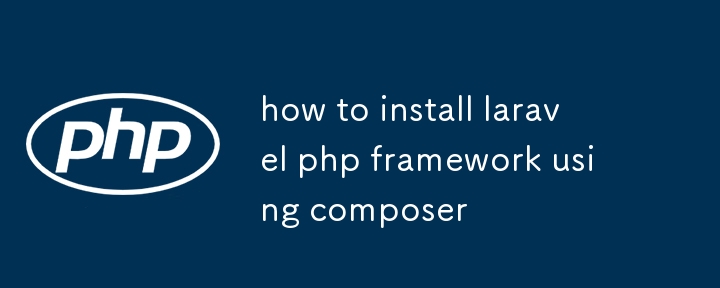
how to install laravel php framework using composer
Article Introduction:The steps to install the LaravelPHP framework are as follows: 1. Make sure that the system has PHP>=8.0, Composer and related extensions installed, and can be verified through php-v and composer--version; 2. Use the Composer command composercreate-projectlaravel/laravelyour-project-name to create a project. Windows users may need administrator permissions, and domestic users can configure mirror acceleration; 3. Set storage and bootstrap/cache directory permissions, generate .env files and configure database information; 4. Run phpartisa
2025-07-07
comment 0
645

How do I use asset bundles in Yii?
Article Introduction:Using Yii's assetbundles is a best practice for managing CSS and JS files. It defines resource groups centrally through PHP classes, and automatically handles dependencies, merging and caches. 1. The resource package is a PHP class used to organize CSS, JS and other resources and declare their dependencies; 2. Register resource packages in the view or layout to automatically generate HTML tags; 3. Different resource packages can be conditionally registered according to user role or page type; 4. The resource files are placed in web/css and web/js by default, and the path can be customized; 5. Use the assetManager configuration to add timestamps to achieve version control, solving browser caching problems. Correct use of resource packages can improve project structure clarity and loading efficiency
2025-07-08
comment 0
808
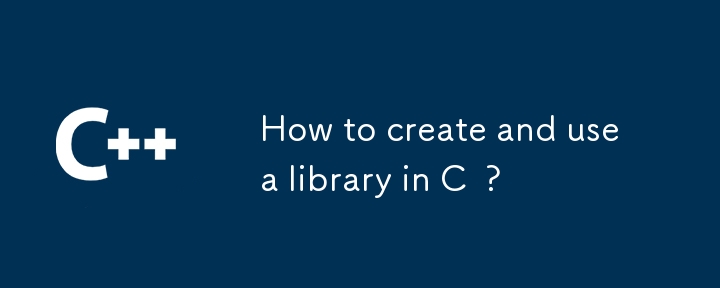
How to create and use a library in C ?
Article Introduction:Creating and using libraries in C is for code reuse and modular development. 1. To create a static library, you need to write the source code and compile it into a target file, and then package it into a .a or .lib file, and you can link it when using it; 2. To create a dynamic library, you need to compile it into location-independent code, and then generate .so or .dll files, and load it at runtime; 3. When using the library, you need to ensure that the header file matches the library version, avoid mixing static and dynamic libraries, and troubleshoot link errors through tools; 4. It is recommended to install third-party libraries through the package manager to reduce configuration problems; in summary, the core lies in standardizing interfaces, correct compilation and reasonable references.
2025-07-23
comment 0
191
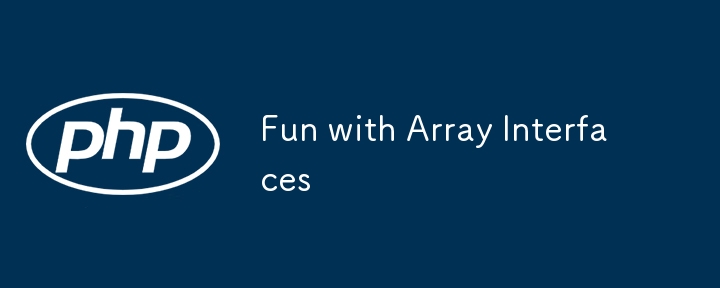
Fun with Array Interfaces
Article Introduction:Key Points
PHP's array interface allows programmers to simulate the characteristics of native data types in custom classes, similar to Python's methods. This enables custom classes to work like arrays and allows common array operations such as counting elements, looping through elements, and accessing elements through indexes.
An interface is like a contract for a class, specifying the methods that a class must contain. They allow encapsulation of implementation details and provide syntax sugar, thereby improving the readability and maintainability of the code. PHP provides a library of predefined interfaces that can implement these interfaces to make objects similar to arrays.
Countable, ArrayAccess and Iterator interfaces in PHP allow objects to pass cou respectively
2025-02-22
comment 0
532

How do I install the dependencies listed in my composer.json file? (composer install)
Article Introduction:The most direct way to install dependencies is to run composerinstall. The specific steps are as follows: 1. Make sure that Composer is installed, and you can check the version through composer--version; 2. Enter the project root directory and execute composerinstall. This command will install dependencies based on composer.json and composer.lock, generate automatic loading configurations and store them in vendor/directory; 3. You can use --no-dev to skip development dependencies, -o optimization class loader, --prefer-dist priority download of zip files, etc. to enhance control; 4. If the installation fails, common reasons include incompatible PHP versions and lack of extensions
2025-07-16
comment 0
583

Jumping from PHP to Go: Blasphemy, Bravado or Common Sense?
Article Introduction:Core points
Migrating the underlying Laravel application of Boxzilla applications from PHP to Go ends up with a more efficient program with better performance, easier deployment and higher test coverage, despite initial concerns about potential business risks.
Go is a compiled language with a standard library that is better than PHP, and can generate faster, smaller applications with fewer lines of code even if external dependencies are considered. The conversion from PHP to Go needs to adapt to new syntax and features, but the end result is considered worthwhile.
Despite PHP's larger community and rich resources, Go's growing popularity, ease of use, and excellent performance features make it a strong contender for developers to consider conversions. The author predicts that the future will be
2025-02-10
comment 0
497
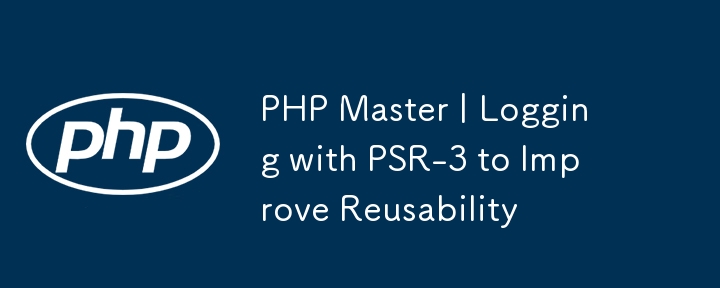
PHP Master | Logging with PSR-3 to Improve Reusability
Article Introduction:Core points
PSR-3, a common log object interface, allows developers to write reusable code without relying on any specific log implementation, thereby improving compatibility between different log libraries in PHP.
The PSR-3 interface provides eight methods to handle messages of different severity levels, and a common log() method that can receive any severity levels. Its design is to solve the problem of log implementation incompatibility.
Although PSR-3 has many benefits, some log libraries do not support it natively. However, developers can create PSR-3 compliant adapters by leveraging the adapter pattern and extending the AbstractLogger class provided in the Psr/Log library.
Many major PHP projects
2025-02-24
comment 0
1299


